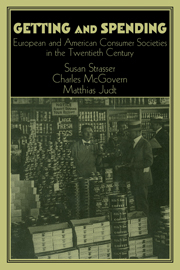Book contents
- Frontmatter
- Introduction
- Part One Politics, Markets, and the State
- 1 The Consumers' White Label Campaign of the National Consumers' League, 1898-1918
- 2 Consumption and Citizenship in the United States, 1900-1940
- 3 Changing Consumption Regimes in Europe, 1930-1970: Comparative Perspectives on the Distribution Problem
- 4 Customer Research as Public Relations: General Motors in the 1930s
- 5 The New Deal State and the Making of Citizen Consumers
- 6 Consumer Spending as State Project: Yesterday's Solutions and Today's Problems
- 7 The Emigré as Celebrant of American Consumer Culture: George Katona and Ernest Dichter
- 8 Dissolution of the “Dictatorship over Needs”?: Consumer Behavior and Economic Reform in East Germany in the 1960s
- Part Two Everyday Life
- Part Three History and Theory
- Index
4 - Customer Research as Public Relations: General Motors in the 1930s
Published online by Cambridge University Press: 05 January 2013
- Frontmatter
- Introduction
- Part One Politics, Markets, and the State
- 1 The Consumers' White Label Campaign of the National Consumers' League, 1898-1918
- 2 Consumption and Citizenship in the United States, 1900-1940
- 3 Changing Consumption Regimes in Europe, 1930-1970: Comparative Perspectives on the Distribution Problem
- 4 Customer Research as Public Relations: General Motors in the 1930s
- 5 The New Deal State and the Making of Citizen Consumers
- 6 Consumer Spending as State Project: Yesterday's Solutions and Today's Problems
- 7 The Emigré as Celebrant of American Consumer Culture: George Katona and Ernest Dichter
- 8 Dissolution of the “Dictatorship over Needs”?: Consumer Behavior and Economic Reform in East Germany in the 1960s
- Part Two Everyday Life
- Part Three History and Theory
- Index
Summary
In the summer of 1926, members of the General Sales Committee of the General Motors Corporation (GM) discussed a tantalizing “specialized” sales strategy. A direct-mail booklet “featuring all GM products,” it appeared, might tap a “particularly fertile field” That market, identified for a targeted campaign, consisted of “Ford owners of two years standing.” The conception of this group as worthy of special sales promotions from General Motors did not stem from some capricious whim or from some motive of vengeance induced by intense corporate rivalry. Every aspect of the underlying logic of the proposed campaign drew its credibility from an exercise in what would come to be called “customer research.”
The architect of this aggressive strategy was Henry (“Buck”) Weaver, later characterized by the public relations counselor Edward Bernays as “a brilliant enthusiast” and “a loose wheel” within GM management. In 1926, Weaver served as “assistant to the director” within the Sales Section at the corporation's Detroit headquarters. Through questionnaires in the form of a “postcard analysis of consumer preferences” of thousands of car owners, Weaver had determined that they were buying new cars at an average frequency of two and one-half years. He also noted that a slightly decreasing percentage of owners of Ford cars were expressing the intention of buying a Ford the next time. Therefore, some seven thousand owners of 1924 Ford cars could be expected to be prime candidates for a new GM car in 1927. Not only would a direct-mail campaign to all owners of two-year-old Fords be likely to recruit those seven thousand for GM, Weaver speculated, but such a strategy might “bring about dissatisfaction on the part of still further Ford owners.”
- Type
- Chapter
- Information
- Getting and SpendingEuropean and American Consumer Societies in the Twentieth Century, pp. 85 - 110Publisher: Cambridge University PressPrint publication year: 1998
- 8
- Cited by



